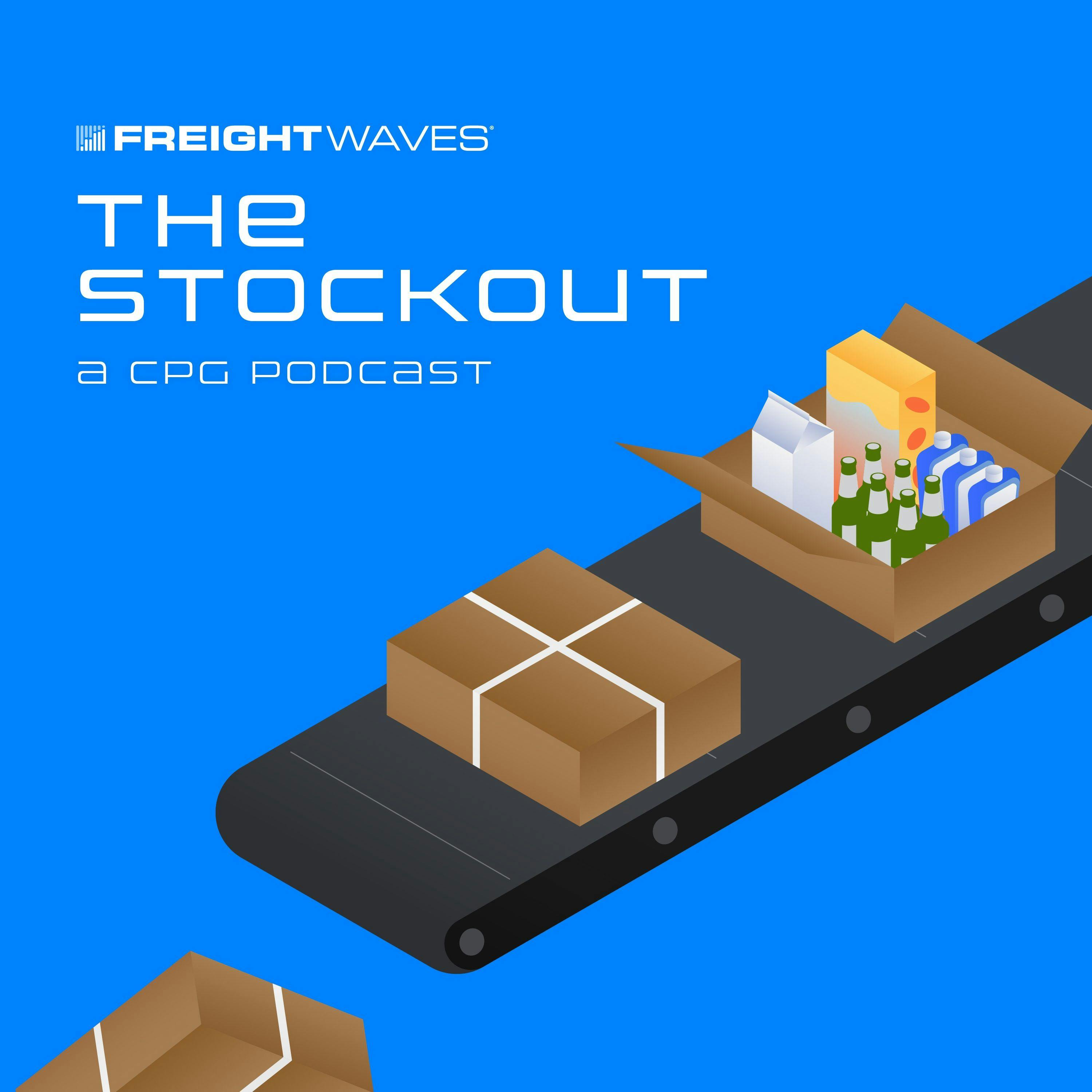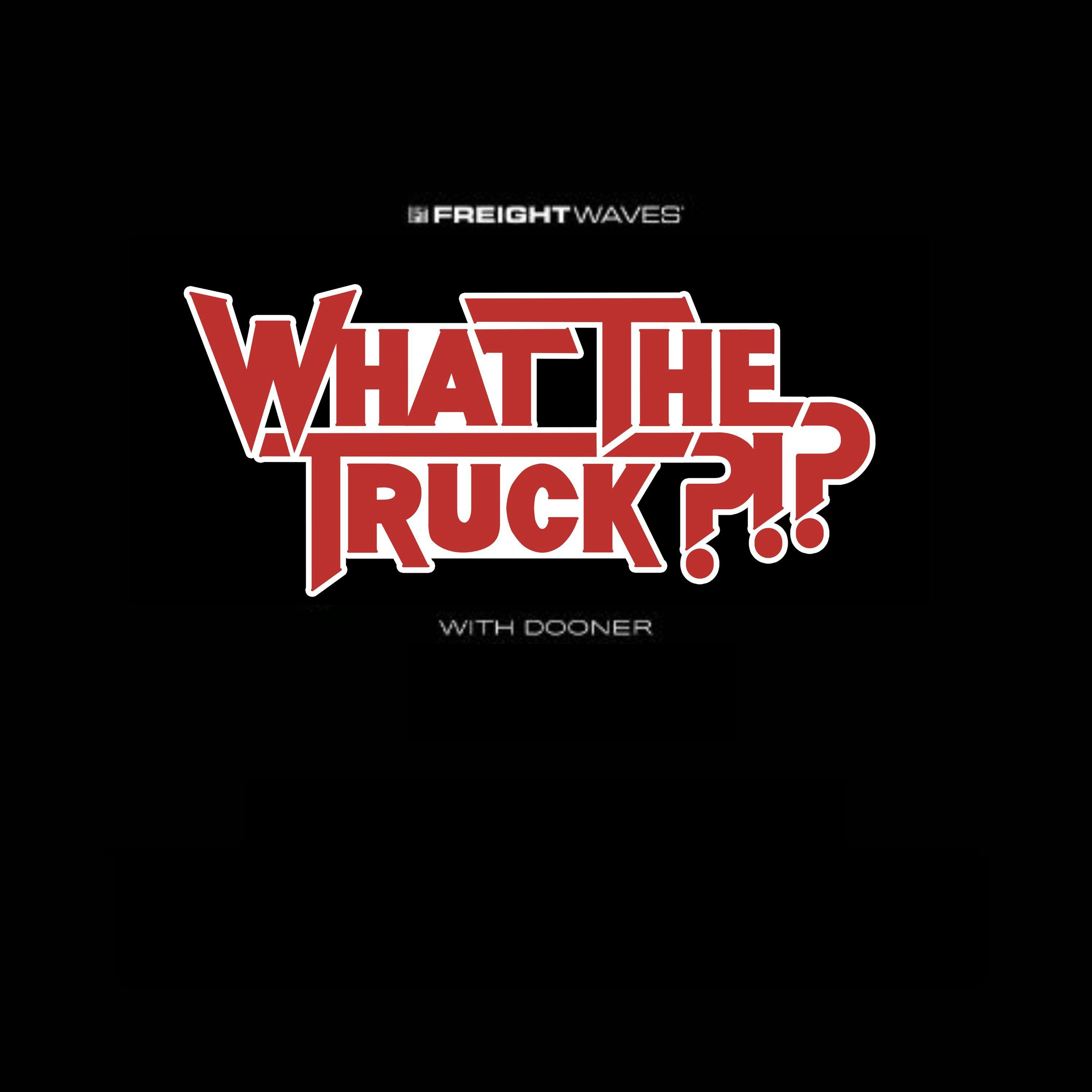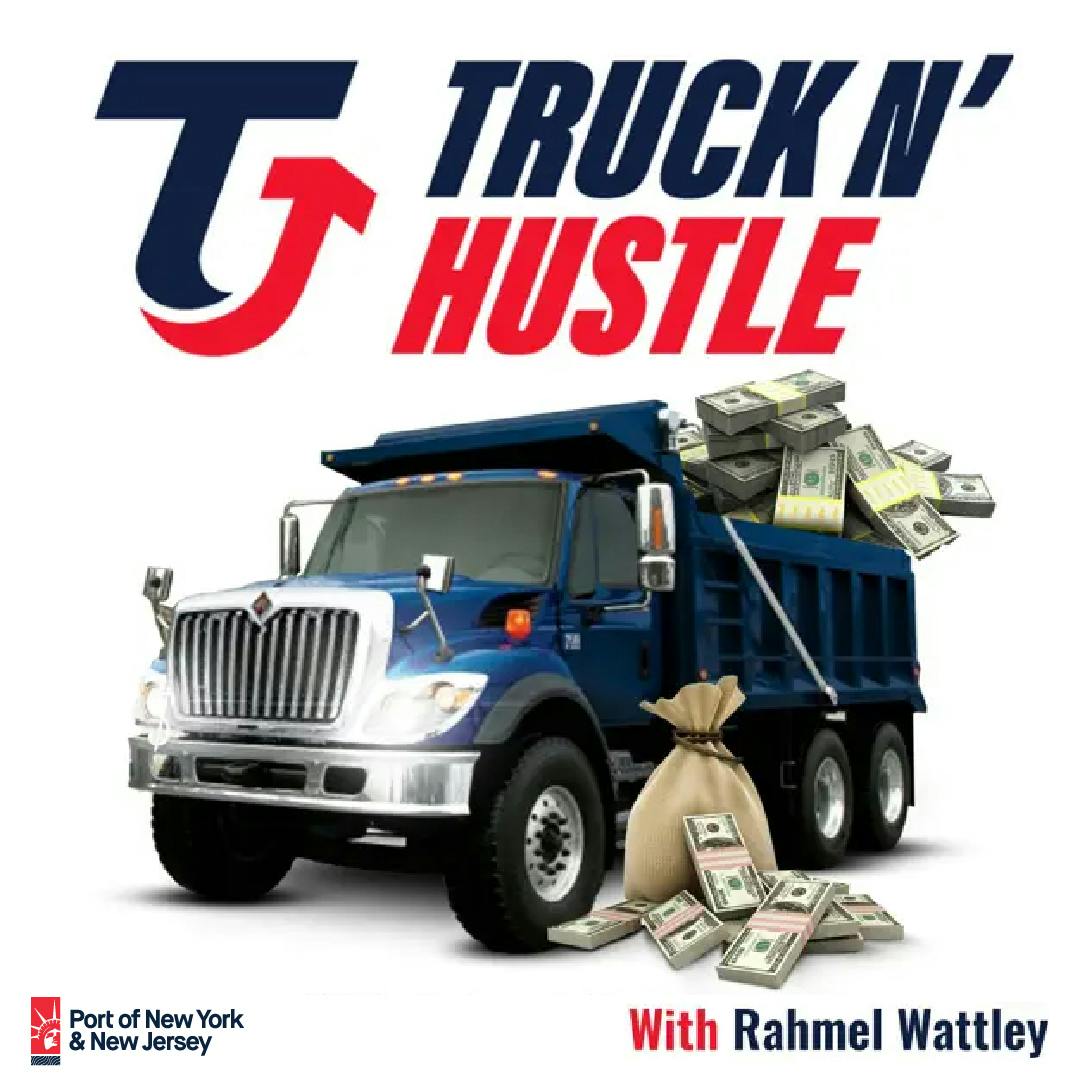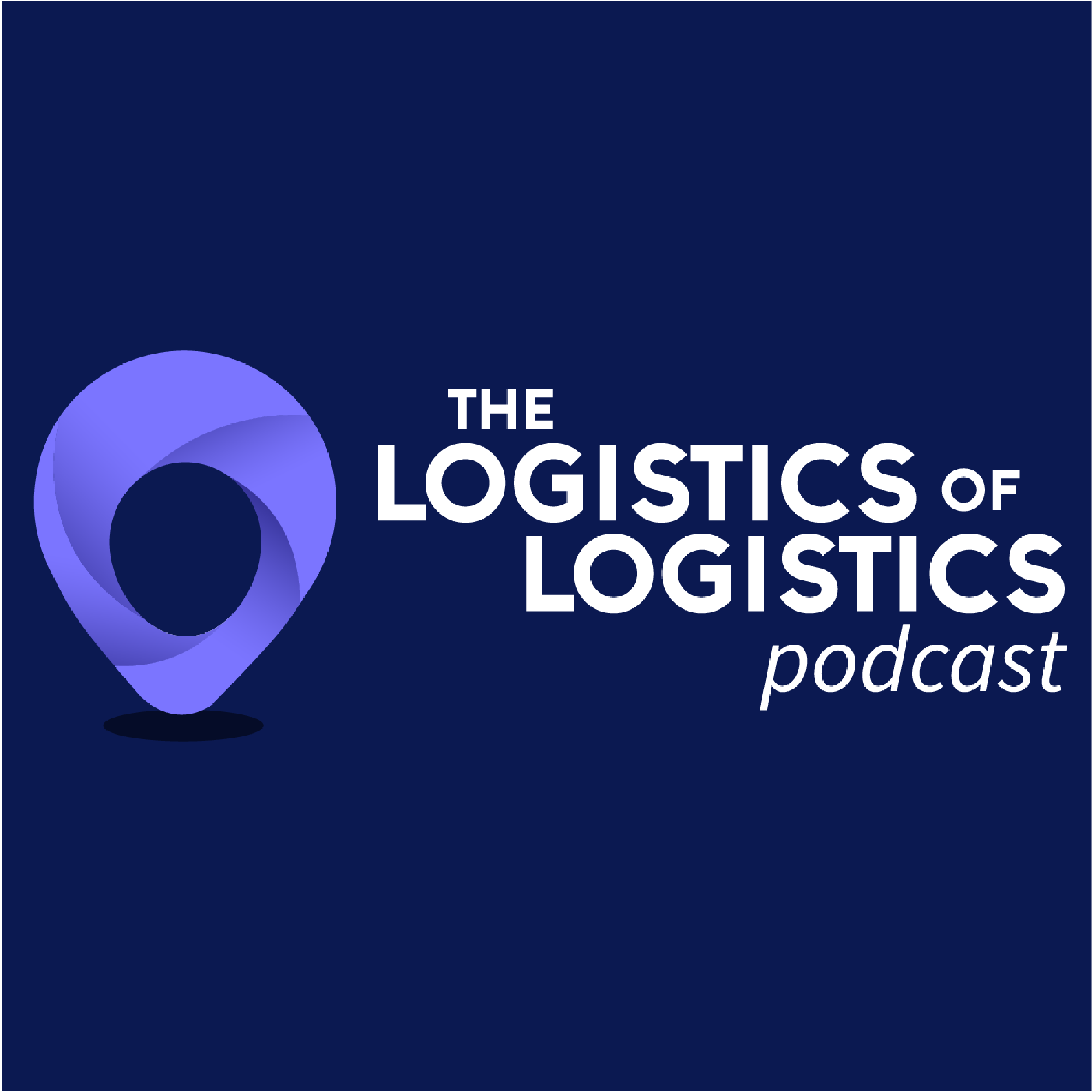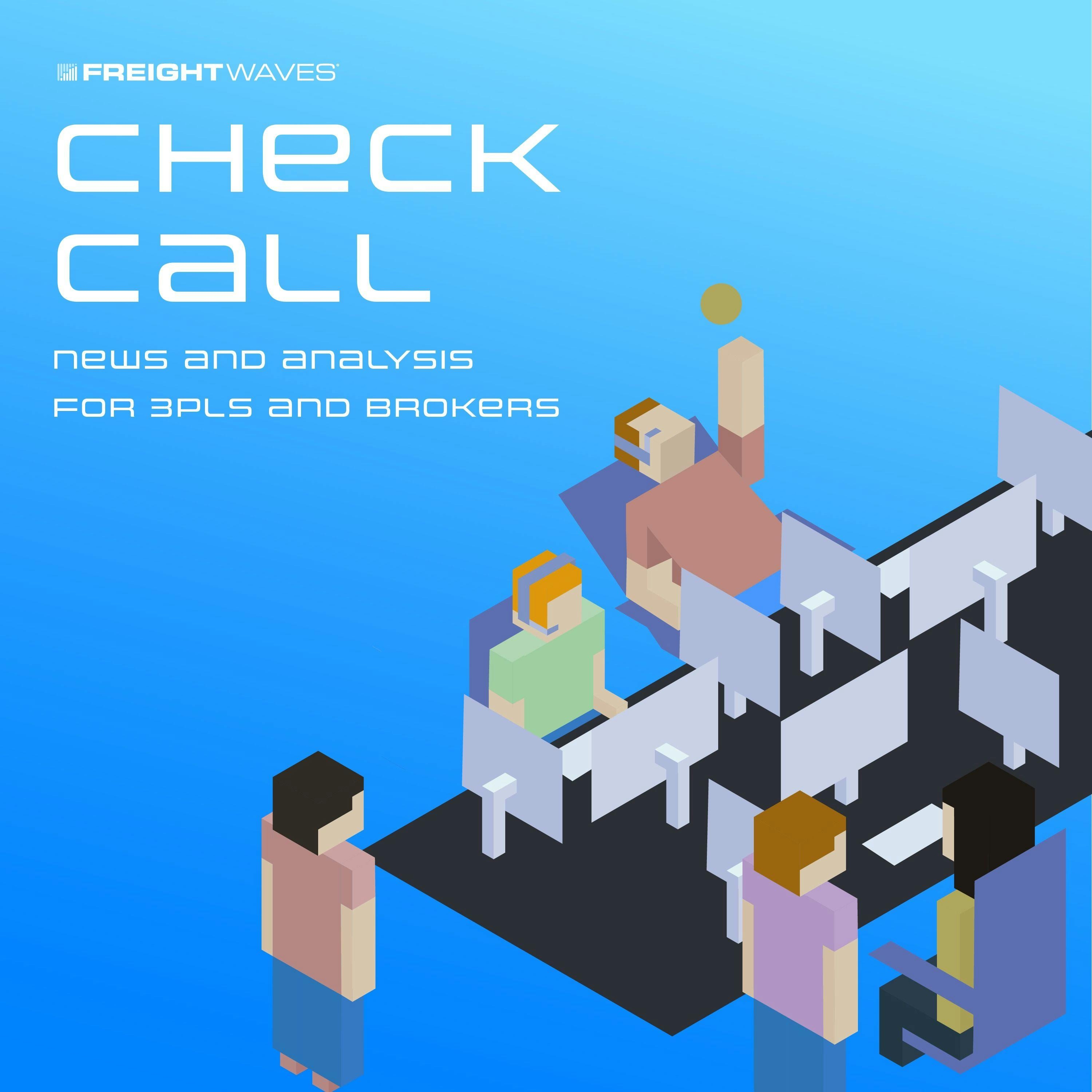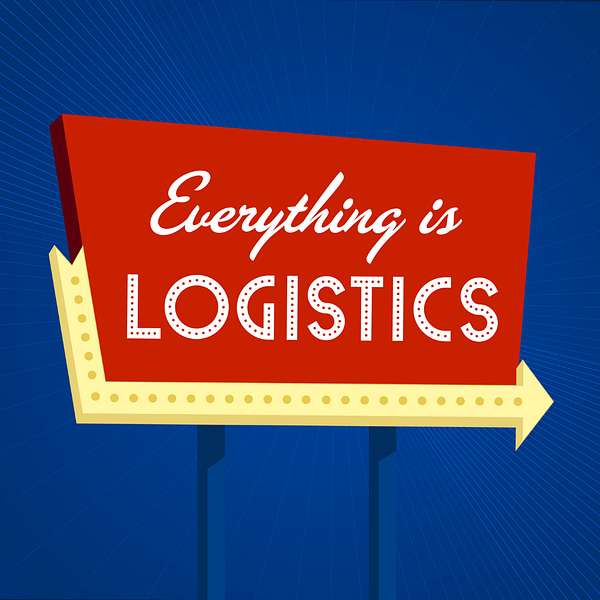
Everything is Logistics
A podcast for the thinkers in freight. Everything is Logistics is hosted by Blythe Brumleve and we're telling the stories behind how your favorite stuff (and people!) get from point A to B.
Industry topics include freight, logistics, transportation, maritime, warehousing, intermodal, and trucking along with the intersection of technology and marketing within the industry.
120k downloads and rated as a top 5% podcast out of all industries and growing. Follow along to stay curious and become a better thinker in freight.
Everything is Logistics
NASA Series: How to Grow Food in Space
In part two of our NASA series, Blythe speaks with Matthew Mickens, NASA Horticulturalist, about how scientists are tackling the challenges of growing crops in microgravity, from specialized hydroponic systems to light recipe experiments. They also talk about the psychological benefits fresh produce provides for astronauts and how Earth-bound vertical farming draws inspiration from space research.
LINKS:
Feedback? Ideas for a future episode? Shoot us a text here to let us know.
---------------------------------------------
THANK YOU TO OUR SPONSORS!
Are you experienced in freight sales or already an independent freight agent? Listen to our Freight Agent Trenches interview series powered by SPI Logistics to hear directly from the company's agents on how they took the leap and found a home with SPI freight agent program.
Tai TMS is designed to streamline your brokerage operations and propel growth for both FTL and LTL shipment cycles. Book a demo with the Tai team today and tell them Everything is Logistics sent you.
Digital Dispatch maximizes your #1 sales tool with a website that establishes trust and builds rock-solid relationships with your leads and customers. Check out our website services here.
Welcome into another episode of everything is logistics, a podcast for the thinkers in freight. I am your host, Blythe Brumleve, but we are proudly presented by SPI Logistics, and I've got another great episode for y'all today, and that is part of our space logistics series. And in this particular episode, we are going to be talking about how to grow plants in space. Now you might be thinking, why do we need to even think about growing plants in space? Like, what is the possible benefit that that could provide? Well, on a recent NASA behind the scenes trip, I can't even believe I get to mutter those words behind the scenes trip of a NASA launch, and also a SpaceX launch for the goes you satellite. I was honored to be among this group called NASA Social, which is essentially a PR effort from NASA and from all of the 1000s of workers that work for the company in order to raise brand awareness around what they do. Not that NASA needs brand awareness at all, but be able to give creators from all walks of life an inside look as to what goes into a NASA launch. Also, SpaceX was part of this mission because it was a mission for the goes, you satellite. And so just a little bit of a background on the reason that I was at NASA is because there's this NASA Social thing that they or program that they have. And periodically throughout the year, they used to do a lot of them, pre covid, now, post covid, they've had a couple of these NASA social events will they will invite influencers, creators from all over the country, to come and get you know, sort of a behind the scenes tour of a launch. Hopefully be able to witness a launch. I was very lucky in that this was my third or fourth time applying for this NASA Social program. Finally got there, was able to do the tour, got accepted into the program and or the, I guess it's considered a program anyways. But one of you know, launches are very testy because of the Florida weather, especially in this time of year, which is June, so summertime, rainy storms in the afternoon, damn near every day in the state of Florida. So launches can be a little you know, timing is important, and so for a lot of these folks, it was kind of waiting on pins and needles, just hoping that you will be able to see the launch at the end of the two day tour. We were lucky enough for that to happen. So basically, it's two days of recording content all over the place, doing different tours and talking to different folks from different positions all over NASA, which was just incredible. So this is part of I don't want to give an exact number right now. I'm looking at about five episodes. But I don't want to limit myself to just five episodes, because I met so many freaking smart people on this trip, and so I will be talking to more of those experts, especially when it comes to logistics and weather and how both of those things affect, you know, supply chains all across the globe. So that is coming soon, but with all of that said in this episode, going to be talking about how to grow plants in space, and this is one part of the tour that was just endlessly fascinating to me. You can see the plants behind me. If you're listening on audio, you can't really see it, but you can kind of visualize it. But I am. I'm plant mom. I have a probably close to 100 plants in my, you know, small, you know, duplex that I live in, in Jacksonville, Florida. And so I'm a plant enthusiast. And so when you when you think about the mission of NASA, the mission of SpaceX, and that is to extend humans beyond Earth. How do you make that happen? What are the logistics behind making that happen? And one of the key aspects of that is feeding your astronauts, feeding your smart people that are in space. And so that's exactly what this department does. And so I was honored enough to see that department behind the scenes and get up close and personal with a lot of the different programs that they're doing, a lot of the different testing, how they're using technology and plants together, what kind of foods that they actually transport up into space. And so if any of that is interesting to you, this is going to be probably a really good episode for you to listen to. So hopefully you stay listening. Hopefully you stay watching. This is a I will say this is an episode, and all of the space logistics episodes, honestly, are going to be better viewed on YouTube. So if you are listening to the audio format, I'm going to try to explain it as best as I can, but to. Really get the full visual of everything that's going on in these space logistics episodes. You really want to watch the video version that's over on YouTube. Just search for everything as logistics, and you should be able to find that. And we will also work on creating a landing page for all of the space logistics episodes, and I'll link to that in the show notes, just to make it easy for folks, in case you do find this in the podcast format and you want to be able to watch the video format. So with all of that said, let's get into it. Okay, so sort of set the stage a little bit for this video. This is so we're, we're inside one of the NASA buildings, and we're taking, being, taking from sort of room to room, from expert to expert, and just learning more and more about different things. So in this first clip, I'm going to show you the entry to the sort of space plants area, which is really cool. I'm probably not going to do this for other videos, but it is cool for the space plants area because you have a lot of botanists in there. You have a lot of people from all different kinds of career backgrounds that are working specifically on this issue of trying to grow plants, trying to test them, and trying to test, you know, different growing conditions, with or without, water, with or without, different lighting. But before we get into that building, before Matthew, the tour guide, host and one of the botanist experts that are working for NASA. I'm going to let him kind of take over. But first I wanted to show you this sort of like walk in part, which is really interesting, because they have, you know, different, you know, big murals, in case you're just listening to the different murals on how they're using different space plant growing just, you know, quotes on the wall, things like that. But in this next video, it's kind of funny. You can see that they have a little bit of a sense of humor, because they have aliens that are growing plants. And it's on one of the doors very clearly it's aliens. And, you know, it's probably just poking fun at a lot of the different jokes. And then, you know, as we're walking into the building or into the room where Matthew is about to start giving his part of the tour, you can also see the sticky flooring on the ground, which you can also hear that as you're walking in, everybody has to step on this sticky floor to get rid of anything, you know, any kind of contaminants that might be on your feet. So I thought that that was really interesting. And, you know, I wanted to make sure that y'all saw that. So with all of that, really said, I'm going to play the Matthews intro, his basically what his entire department does
Matthew Mickens:chamber area. So we basically do all of our ground research to figure out what's the best way to grow crops in space here, we do a lot of our screening in terms of what's the best crops to select, but also, can we grow crops in environmental conditions that are relevant for space. So for instance, here on the ground, this is basically where we would be. We study different hardware systems, different technologies, also human practice testings. We do have taste testings, because what we grow, we got to make sure it tastes okay for the permit, because that's important. The psychological aspect of props in space is, you know, of high value, because abstracts, when they are in space, they do lose weight. And so there's a, there's a phenomenon called menu fatigue. You know, their diet is mostly packaged, and so there's not a lot of diversity, and sometimes fresh rocks can actually help solve that. And so that's a big place where plants actually can be of benefit. But also we utilize the International Space Station because it is a platform where, or even a laboratory where we can have access to micrographs, right? You have to imagine trying to grow crops when there's no gravity, using water, water becomes totally different, and actually becomes a big challenge when we're talking about growing crops. And so right now on the ISS, you can see we've got these two big roll holes here. Those are our two main plant growth platforms. One is called the vegetable production chamber. We call it veggie that's our simplest chamber. It's just basically lights and fans, and it actually the plants we grow in there share the environment with the food. The more advanced system is the advanced plant habitat. We're doing what our brain for today looks like. So the advanced plant habitat has over 180 different sensors. It's completely sealed and closed pretty much you can control your sealed tube very precisely, but also has more advanced lighting and watering, active watering capabilities. And so we've basically been. Growing crops and needs to the platforms since 2014 but still, we've got a long way to go. And so basically from ISS. And as you may know, ISS will be retiring by the year 2030 and so the next platform is gateway. Gateway will be in a further out orbit, what we call cislunar space. It will allow us to have access to a higher radiation environment. It will be quite small, smaller than the ISs, but still valuable in terms of allowing us to further plant research. And then, of course, we are going back to the moon. And so we are working, actually, with the Canadian Space Agency on how we can have different demonstrators between crops on the surface of the moon. But also the lunar surface is going to be a huge opportunity to get practice when we go to Mars, which is next. So we've got the Mars transit vehicle area where plant broom will be required. That's a nine month trip at least. And so then we're talking about moving away from research and actually utilizing plants as a supplemental food option for the fruit. So it's going to be even more important that we figure out, you know, what's the best in terms of food safety, or, you know, what's the practical or the most beneficial crops for a transit mission? And then surface habitats, of course, that'll allow us to grow, you know, in larger footprints, larger crops, you know, even staple crops like corn or soybeans, things like that, or even utilizing techniques such as hydroponics. So you can see in all of these aspects of space, space exploration, plant growth, research, or plant growth as a supplement to the diet is going to be necessary. All right. So, again, this is just a high level road map, but you can see where we all fit in.
Blythe Brumleve:Are you in freight sales with a book of business looking for a new home, or perhaps you're a freight agent in need of a better partnership. These are the kinds of conversations we're exploring in our podcast interview series called The freight agent trenches, sponsored by SPI logistics. Now I can tell you all day that SPI is one of the most successful logistics firms in North America who helps their agents with back office operations such as admin, finance, it and sales, but I would much rather you hear it directly from SPI freight agents themselves. And what better way to do that than by listening to the experienced freight agents tell their stories behind the how and the why they joined SPI hit the freight agent link in our show notes to listen to these conversations. Or if you're ready to make the jump, visit SPI three, pl.com
Matt Wittal:Any questions so far? No, sir. But are there different plants that are more sensitive, just
Unknown:basically different than others? You guys have a sort of area of
Matt Wittal:that that is better for it. So really good question. So we have Chrome crops, actually, the pictures, as you can see on the wall above you, you can see Scott Kelly and Kelvin are handing lettuce, and then Peggy puts it in, throwing cabbage. So for instance, our cabbage crops didn't grow as well. And you know, it can be a combination of the lack of gravity, but also, like LED lighting or elevated CO two, like all of those things, can cause issues for different crops. Some crops can do better. Some crops not so much. And so this is where we can actually simulate those conditions. Here, figure out, well, what can we spray it out? What products can we buy that makes sense?
Blythe Brumleve:How accurate was Matt Damon and on Mars growing the potatoes.
Matt Wittal:Oh, man, I love that movie. Any scientist watching that movie as a scientist, you got to pick things out. I don't know how safe it would be to use species that sort of, you know, that's in my mind. I'm the point of contact for the same year, and trying to figure out, what are the hazards of E coli. You know, you don't want any opportunities for that, but also raw potatoes, that is something that is actually not new we so let me bring you over here. This model here that you see, this is called the biomass production table. It was active here at Kennedy Space Center at Hangar L from 1987 to the year 2000 and in this it's basically a completely closed chamber, but it actually had different layers, like vertical farms. And NASA was actually vertical farming before vertical farming existed, and one of the crops that grew in there were hydro. Like potatoes. So actually, the movie kind of got some of its intel from research that we had already been doing here for 20 years. Wow. And so it's no longer existing now, but it's been, you know, in terms of being a pioneer for what we call controlled environment, agriculture, all of that actually started here in the efforts for SpaceX. Yes, it is. I was actually going to get you that. So growing beyond Earth definitely is an outreach tool that we've had in collaboration with middle schools and high schools in Florida. So yeah, we have these in the classrooms where the students can actually grow plants and make recommendations for us here at NASA on what's the next prop for us fly clinics, and so far, we've actually gotten at least two crops as recommendations for us and we fly it would clone them as a result of the citizen science research that happens in the growing beyond Earth program. I think one of them was drag on lettuce and pop toy. Those were the two crops that they were that they ended up recommending to us, and we blew them, and they grew great. And we actually have some drag room going and one of the chains now, do you have
Unknown:any recommendations of I'm educator. I'm a director of STEM at a private school. I have a greenhouse that was just installed, and I'm using the average economy aeroponic towers. So they're eight feet tall. They dribble in three minutes. Turns off 12 minutes. I can have between 54 and a half and 44 crops, depending on the density of the root ball. They go in the cocoa pod. Things, is there anything that we can do, Citizen Scientist wise, that you're aware of, botanically, that we can provide data to experimentations? I have a GbE box that we're also going to put in the classroom. I have this big, huge greenhouse I can use, and it has a super, super duper, highly controlled system that's run by not some vision anyway, but all electronically controlled, humidity, everything's everything's there. Is there any program that you can think of off the top of your head that might be possible for us
Matt Wittal:to do you think like something to test that would be beneficial for us?
Unknown:Yes. Is there something like I use NASA's best curriculum for engineering? Is there something already out there that I might not be aware of because GbE was all like the title,
Matt Wittal:yeah, you don't have to answer me now, yeah, yeah, no, because I'm actually, I've been working with some of the GbE educators as well, and I think we're in a process of coming up with a curriculum or something that may help us. Like, for instance, I mentioned menu fatigue and taste profile. I know with the GbE boxes, you can tune the color of the lights, and so I was actually kind of recommending that see if they can modify the taste, like for instance. So in the microgravity environment, astronauts sometimes have reported losing or diminishing their sense of taste. So a lot of them are asking for spicier foods. So I was wondering, you know, well, can we modify the taste in space using the lighting that's
Unknown:already available? What about the intensity of the UV light that they get? I can vary that, or is that less interesting than the color of
Matt Wittal:the light? Well, that is saying you can change the color of the light itself. Light recipes, basically, and that will and certain spicy crops, or, like arugula, bread slice, one of the crops that I've been trying to push, because you can change the taste by changing, for instance, a ratio of certain colors. And so that's just one thing I was thinking of off the top my head. But great question. Anybody else? Okay, I know we don't have much time. You got something? Yeah, so that's green works. It's kind of like our miscellaneous area for like, where we start experiments. We want to try something out quickly. If we have time, I would, I will try to take you over there. But for now, I can mention you may see a lot of tall flowering plants in the corner there. Yeah. So we've got some projects where we're actually growing plants for teas. We've got chamomile growing and so that was trying to actually purposely grow it to flower, to have potential plants that can be made into tea.
Blythe Brumleve:Brokering success demands a battle ready strategy. Thai TMS equips freight brokers with the ultimate battle station for conquering a tough market with Ty, brokers gain access to a comprehensive platform where rate intelligence and quote history converge on a single screen. It's not just a page, it's a strategic command center designed to help brokers win. Thai equips your team with all of the data they need to negotiate with confidence and allows them to communicate directly with carriers and customers for. Them a simple control base revolutionize the way your brokers perform by giving them a competitive advantage with Thai TMS. For more info, go to Tai software.com, backslash battle stations, and we also have a link for you in the show notes to sign up for a demo. Okay, and since Matthew just mentioned growing teas and some of the other plants that they were experimenting on in the other room, I'm going to fast forward just a little bit to show you some of those plants and some of those teas that they are growing. So I'll hit play on that now.
Unknown:I and
Blythe Brumleve:if you couldn't hear in one of the other videos before it cut off, it's, it's probably going to be a future story over on the NASA team, because they mentioned specifically that we know still the tea is probably going to be, you know, a blog post or a social post in the future for the NASA Social team. So I thought that that was cool, too. All right, and in these next couple of clips, we're actually going to be going to the different chambers and being able to take a peek inside of with some of these chambers and how they're simulating the different growing, I guess, experiences that these plants are going to be having, and also testing the actual plant health for when they face, you know, some kind of adversity, you know, in space, and how they react to it in space. And it's really interesting that you know that just at the cellular level, with a lot of plants, and just even the human body in general, it reacts differently in space, and so they're on here on Earth, and inside these chambers are trying to test those different environments. So here's what that process looks like.
Matt Wittal:But the idea of using these walk in chambers is because, I mean, it gives us an opportunity to simulate the environmental conditions on Space Station, in particular the CO tube, but also temperature and humidity. Now, in this chamber, actually, this is a project that's headed by one of our postdoctoral scientists, Dr Luke Falcon, the plants are here are growing on a hydroponic Okay,
Blythe Brumleve:so I had to cut that video off just for a second there, but I'm going to bring up the next clip of him talking a little bit more in depth just about the the different plant health monitoring and also the effects of light therapy on plants,
Matt Wittal:reflective imaging and even Lidar and so and this project, in collaboration with the USDA and the army, is basically, how do we use plant health monitoring to solve and problem? For instance, we're purposely drowning some of these plants. Starting tomorrow, we're going to stop watering the plants to see if we can actually image a stress response. If we can actually predict or see the plants getting stressed before they start wilting, it'll allow us to tell the crew like, hey, it's time to make an adjustment or water the plants before they actually lose their food. And so plant health monitoring is an aspect that we're trying to push here for mission applications. No, they have no idea what's coming. So let me get to it. Skimming. Yes, they do request spicier food sometimes because they do have a diminished sense of taste because of the fluid shifts in microgravity. So yes, transit missions, they we want to be able to, and actually, I'm working on a project now where we can, I'm trying to actually increase the intensity of a flavor of the crop by changing the light recipe. We have the capability, just haven't really tested it yet. So I want to try to test that, to see if we can allow the crew that capability to do that. Oh, yeah. Oh, a lot of the thing, like, yes, like Thanksgiving holidays, they request a lot of the things that you know, they would normally get from home, and we shifted up to them for sure,
Blythe Brumleve:yep, what kind of things are y'all 3d printing comes out?
Matt Wittal:Yeah, that's a good question. I usually will show that stop. So we do 3d print materials, like, for instance, trellises that we use to kind of train the plants. I think we might have some
Blythe Brumleve:love that little clip at the end with one of the other creators that was on site. And you know, we're all sort of, you know, kind of competing to to get as much footage as we can. And so you can kind of see it, not just in this video, but some of our other space logistics videos. All right. Okay, and just to sort of round out this discussion and at the end of it, and apologies again, if you were listening on audio, this is going to be much better for you if you actually watch the video. But I'm going to run through a few of the images that we were able to that I was able to snap while on this particular part of the tour. So let's run through some of these images, and now what you're looking at on the screen right now is basically one of the chambers. And so in front of each of the chambers, they have basically a lot of, you know, the different, you know, scientists sort of stats, you know, the start date, the finish date, the duration, what they're actually testing for, environmental set points. So there was a bunch of these chambers, just all over the room and all over the space that we were in. There were also, you know, different scientists that were walking around, basically walking around the tour and just getting their job done. So they paid us no mind. They were completely focused on exactly what they were supposed to be working on. So if you're looking at the screen here, are a few more images. Just, you know, kind of, I thought that these were fun, just kind of showing off a little bit of the humor, very similar to the aliens farming the plants to enter into this part of the tour. But then also, you know, some of the signage that they have all around, you know, the this one in particular, saying, gardeners know all the dirt, and that is some of the tea that they are growing back there. That you can see pictured here are some other different, you know, hydroponic systems that they were also testing as well. And so if you're looking at the little purple things, these are basically the water that they're trying to feed into the plants. Because if you think about it, you have to be very careful with how you water plants in space. There's no gravity, and so it's a little bit challenging to water plants in space. And so this was one of the ways, and one of the methods that they were testing from a hydroponic perspective here were just some other just like random, I think, photos. What is this one? Yeah, these are different photos of different tours and things that you know that this particular division has participated in going through some of these other like, sort of B roll. If I go, if I scroll back one more, really quick, you can see some of the different plants, the the leafy greens that they were talking about. So that's going on in this particular clip of some of the astronauts that were able to, you know, eat some of those leafy greens. And they mentioned that, basically leafy greens, and the reason that they grow so many of them in space, is because they reproduce, and they grow really quickly, and they also survive a lot of different, you know, environmental things here on planet Earth, and so it's thought that they would be able to survive better, or be one of the more efficient plants to also grow in space, considering the protein count and the nutrition. Here's more of the tea that I thought was also really cool. Just, you know, cool, different video footage. You might have seen that earlier, but I'm going to play it again. Let's see what else we got. Oh, here's some of the chambers that I'm going through, and you can kind of see all of these different experiments that are going on. And in that particular clip, these are the poor plants that they were actually going to be drowning the next day just to stress test them in order to see if they'll be able to survive that stress test. And yeah, that kind of ends it for the B roll, alright. Well, that about does it for this special episode of our space logistics series. I hope y'all enjoyed it, and hopefully you were able to watch it, and if you were listening, hopefully it was still enjoyable, even if you didn't watch it. But if you do want to watch it, I highly encourage you to check that link in the show notes, or head on over to our YouTube channel over at everything is logistics, and you'll be able to see the full version. But Be on the lookout for other episodes from our space logistics series that are going to be coming out in the coming weeks. We're going to be talking be talking about Deep Space logistics. We're going to be talking about what goes into a NASA launch. We're going to be talking about, you know, the infrastructure that you have to set up in space itself. And then we're also going to be hearing from those scientists from NOAA. That is the National Oceanic, Atmospheric Association. I don't I think it's not Association. It's something else. So I'm blanking on that, but we will get that. I'm just gonna look it up right now. So, no, A, A, yes, administration, not association. So administration, nationalist, Oceanic and Atmospheric Administration. So be on the lookout for that episode, I will have that acronym correct by then. So thank you all for listening and hope you enjoyed it. I hope you enjoyed this episode of everything is logistics, a podcast for the thinkers in freight, telling the stories behind how your favorite stuff and people get from point A to B. Subscribe to the show. Sign up for our newsletter and follow our socials over at everything is logistics.com and in addition to the podcast, I also wanted to let you all know about another company I operate, and that's digital dispatch, where we help you build a better website. Now, a lot of the times we hand this task of building a new website or refreshing a current one off to a co worker's child, a neighbor down the street or stranger around the world, where you probably spend more time explaining the freight industry than it takes to actually build the dang website. Well, that doesn't happen at Digital dispatch. We've been building online since 2009 but we're also early adopters of AI automation and other website tactics that help your company to be a central place, to pull in all of your social media posts, recruit new employees and give potential customers a glimpse into how you operate your business. Our new website builds start as low as $1,500 along with ongoing website management, maintenance and updates starting at $90 a month, plus some bonus freight marketing and sales content similar to what you hear on the podcast. You can watch a quick explainer video over on digital dispatch.io, just check out the pricing page once you arrive, and you can see how we can build your digital ecosystem on a strong foundation. Until then, I hope you enjoyed this episode. I'll see you all real soon and go jags. You.



